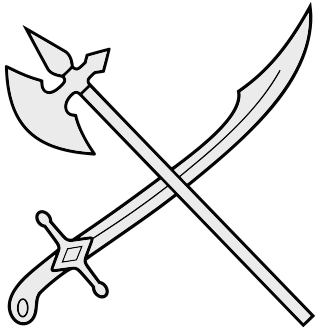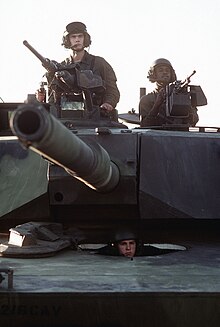
A sidearm is a weapon, usually a handgun, but sometimes a knife, dagger, sword, bayonet, or other melee weapon, which is worn on the body in a holster or sheath to permit immediate access and use. A sidearm is typically required equipment for military officers and may be carried by law enforcement personnel. Usually, uniformed personnel of these services wear their weapons openly, while plainclothes personnel have their sidearms concealed under their clothes. A sidearm may be carried alone, or as a back-up to a primary weapon such as a rifle, shotgun, or submachine gun.
Heavy weapons platoon (HWP) is a term from military science which refers to an infantry platoon equipped with machine guns, mortars, rocket-propelled grenades, flamethrowers, grenade launchers, anti-tank weapons, or any other weapons that are portable but heavier than a single infantryman can reasonably transport and operate by themselves for combat, generally a crew-served weapon. Heavy weapons platoons are grouped into a weapons company or maneuver support company, which focuses on moving and using heavy weapons to support light infantry rifle companies armed with standard-issue small arms.

High-explosive anti-tank (HEAT) is the effect of a shaped charge explosive that uses the Munroe effect to penetrate heavy armor. The warhead functions by having an explosive charge collapse a metal liner inside the warhead into a high-velocity explosively formed penetrator (EFP) jet; this is capable of penetrating armor steel to a depth of seven or more times the diameter of the charge. The EFPs jet effect is purely kinetic in nature; the round has no explosive or incendiary effect on the target.
The blunderbuss is a firearm with a short, large caliber barrel which is flared at the muzzle and frequently throughout the entire bore, and used with shot and other projectiles of relevant quantity or caliber. The blunderbuss is commonly considered to be an early predecessor of the modern shotgun, with similar military and defensive use. It was effective only at short range, lacking accuracy at long distances. A blunderbuss in handgun form was called a dragon, and it is from this that the term dragoon evolved.

A grenade launcher is a weapon that fires a specially designed, large-caliber projectile, often with an explosive, smoke, or gas warhead. Today, the term generally refers to a class of dedicated firearms firing unitary grenade cartridges. The most common type are man-portable, shoulder-fired weapons issued to individuals, although larger crew-served launchers are issued at higher levels of organization by military forces.

A semi-automatic pistol is a handgun that automatically ejects and loads cartridges in its chamber after every shot fired. Only one round of ammunition is fired each time the trigger is pulled, as the pistol's fire control group disconnects the trigger mechanism from the firing pin/striker until the trigger has been released and reset.

This article is about the weapons used in the Vietnam War, which involved the People's Army of Vietnam (PAVN) or North Vietnamese Army (NVA), National Liberation Front for South Vietnam (NLF) or Viet Cong (VC), and the armed forces of the China (PLA), Army of the Republic of Vietnam (ARVN), United States, Republic of Korea, Philippines, Thailand, and the Australian, New Zealand defence forces, and a variety of irregular troops.

The M79 grenade launcher is a single-shot, shoulder-fired, break-action grenade launcher that fires a 40×46mm grenade, which uses what the US Army calls the High-Low Propulsion System to keep recoil forces low, and first appeared during the Vietnam War. Because of its distinctive report, it has earned the nicknames of "Thumper", "Thump-Gun", "Bloop Tube", "Big Ed", "Elephant Gun," and "Blooper" among American soldiers as well as "Can Cannon" in reference to the grenade size; Australian units referred to it as the "Wombat Gun". The M79 can fire a wide variety of 40 mm rounds, including explosive, anti-personnel, smoke, buckshot, flechette, and illumination. While largely replaced by the M203, the M79 has remained in service in many units worldwide in niche roles.
A combat shotgun is a shotgun issued by militaries for warfare. The earliest shotguns specifically designed for combat were the trench guns or trench shotguns issued in World War I. While limited in range, the multiple projectiles typically used in a shotgun shell provide increased hit probability unmatched by other small arms.

The M26-MASS is a shotgun configured as an underbarrel ancillary weapon attachment mounted onto the handguard of a service rifle, usually the M16/M4 family of United States military, essentially making the host weapon a combination gun. It can also be operated as a stand-alone shotgun by attachment to a pistol grip/collapsible buttstock module. Rollout commenced in 2013, replacing the M500 shotguns in service.

A ranged weapon is any weapon that can engage targets beyond hand-to-hand distance, i.e. at distances greater than the physical reach of the user holding the weapon itself. The act of using such a weapon is also known as shooting. It is sometimes also called projectile weapon or missile weapon because it typically works by launching solid projectiles ("missiles"), though technically a fluid-projector and a directed-energy weapon are also ranged weapons. In contrast, a weapon intended to be used in hand-to-hand combat is called a melee weapon.

A riot shotgun is a shotgun designed or modified for use as a primarily defensive weapon, by the use of a short barrel and sometimes a larger magazine capacity than shotguns marketed for hunting. The riot shotgun is used by military personnel for guard duty and was at one time used for riot control, and is commonly used as a door breaching and patrol weapon by law enforcement personnel, as well as a home defense weapon by civilians. Guns of this type are often labeled as breaching shotguns, tactical shotguns or special-purpose shotguns to denote the larger scope of their use; however, these are largely marketing terms.

An entrenching tool (U.K.), intrenching tool (U.S.), E-tool, or trenching tool is a digging tool used by military forces for a variety of military purposes. Survivalists, campers, hikers and other outdoors groups have found it to be indispensable in field use. Modern entrenching tools are usually collapsible and made using steel, aluminum, or other light metals.

A service pistol, also known as a personal weapon or an ordnance weapon, is any handgun issued to regular military personnel or law enforcement officers. Typically, service pistols are revolvers or semi-automatic pistols issued to officers, non-commissioned officers, and rear-echelon support personnel for self-defense, though service pistols may also be issued to special forces as a backup for their primary weapons. Pistols are not typically issued to front-line infantry. Before firearms were commonplace, officers and non-commissioned officers typically carried swords instead.

Trench raiding clubs were homemade melee weapons used by both the Allies and the Central Powers during World War I. Clubs were used during nighttime trench raiding expeditions as a quiet and effective way of killing or wounding enemy soldiers. The clubs were usually made out of wood. It was common practice to fix a metal object at the striking end in order to maximize the injury inflicted. Another common design comprised a simple stave with the end drilled out and a lead weight inserted, with rows of large hobnails hammered in around its circumference. Most designs had some form of cord or leather strap at the end to wrap around the user's wrist. Bosnian soldiers serving in the Austro-Hungarian army were fond of using maces. They were also used by officers to finish enemy soldiers wounded by poison gas attacks.
The Ciener Ultimate Over/Under system is a modified shotgun designed by Johnathan Arthur Ciener. It is mounted under an M16 variant in order to facilitate CQB combat. It is similar to, but uses a different mounting system than the Knight's Armament Company Masterkey or the accessory weapon configuration of the Remington 870 MPS.

An edged weapon, or bladed weapon, is a melee weapon with a cutting edge. Bladed weapons include swords, daggers, knives, and bayonets. Edged weapons are used to cut, hack, or slash; some edged weapons may also permit thrusting and stabbing. Edged weapons contrast with blunt weapons such as maces, and with thrusting weapons such as spears.















